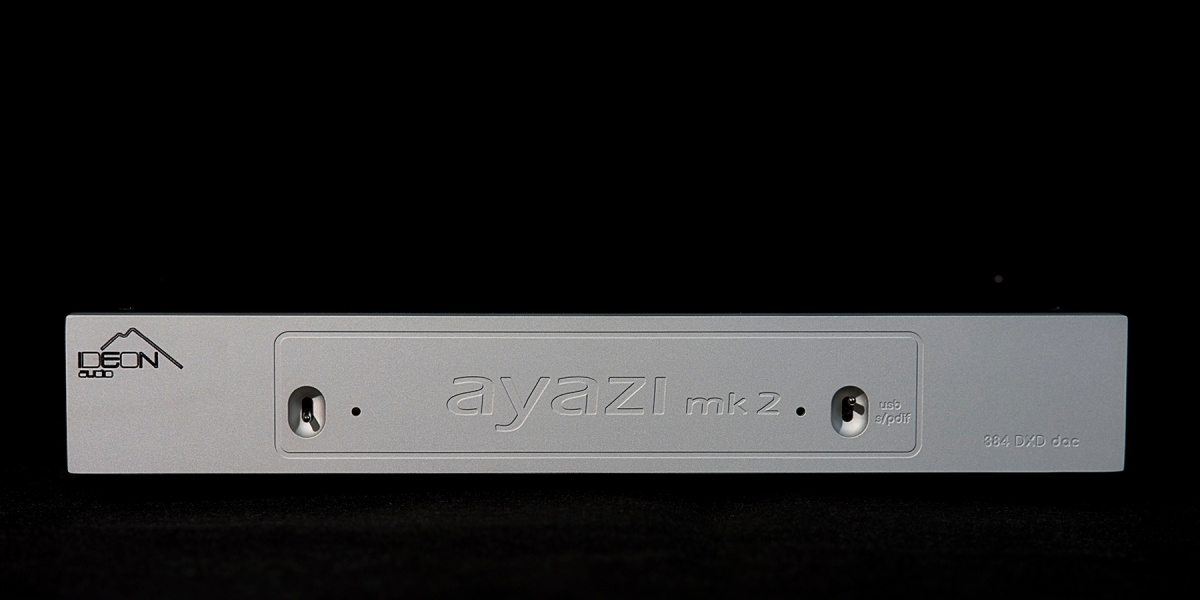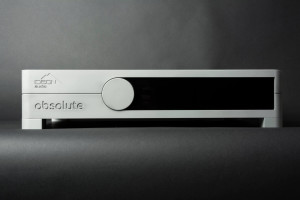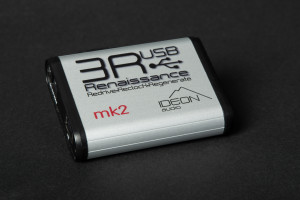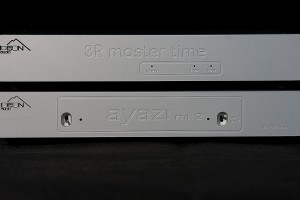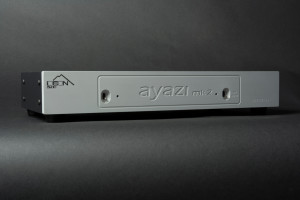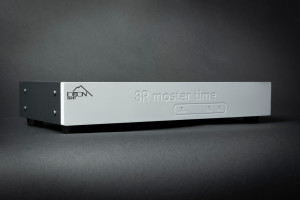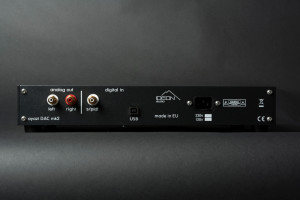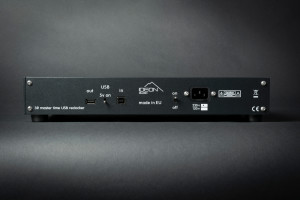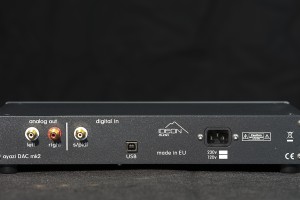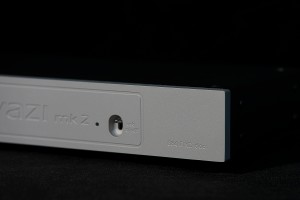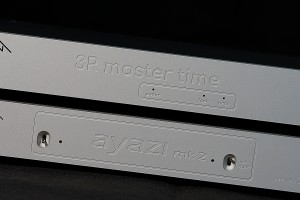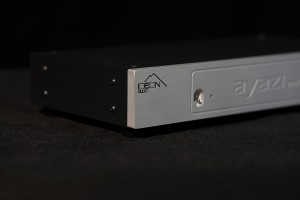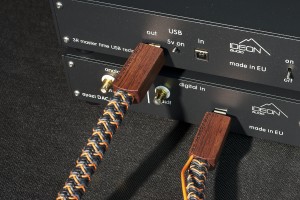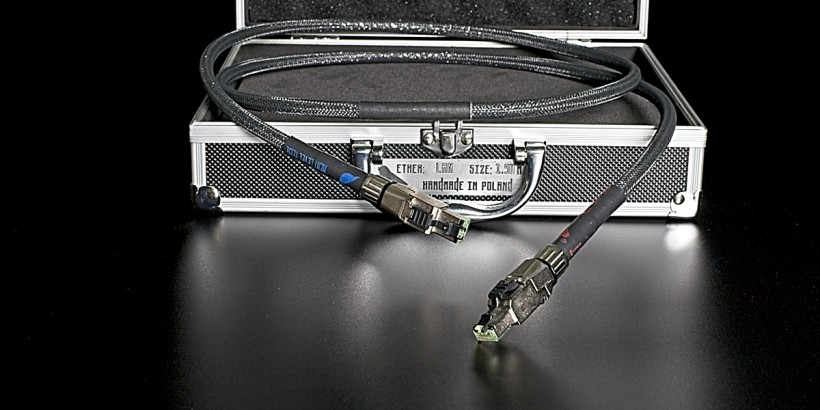Digital to analogue converter has been probably, next to headphones, the most popular type of audio component in the recent years. As the music files have become the most used music medium, DACs have become a must for many, if not most, music lovers. Huge demand resulted in huge supply and strong competition among manufacturers. While that’s usually a good news for end users who can choose among hundreds, maybe thousands of variously priced devices, some might feel overwhelmed with such a big number of possible choices. Let me try to help you a bit and point you to probably not so well-known, but definitely worth getting to know brand from Greece – the Ideon Audio.
Introduction
Those who read some of my recent reviews (hORNS Aria II) already knew that this one was coming too. Both (and some more) were a direct result of a single recommendation from a UK distributor, Greg Drygala, who pointed me towards Lucas Domansky music server as a particularly interesting, high performance product. To check it out I visited his presentation during the last Audio Video Show in Warsaw only to find out that not only the server was worth my attention but virtually every product in this system. I really liked what I heard there so much that I requested all of the products for reviews and already got most of them. One of the participants was a Greek company, Ideon Audio, that, to be honest, was at the time unknown to me. What caught my eye first was their flagship D/A Converter called the Absolute DAC. That’s one really good looking and sounding device! But it wasn’t the only one. The other one, called 3R Master Time, in common terms is a USB re-clocker. One places it in a digital signal chain between an USB source, the LDMS (Lucas Domansky Music Server) in this case, and a DAC. When I visited the room, Lucas was running the presentation and decided to prove to me how good job the 3R Master Time did. He played a few short tracks for me with and without this re-clocker in the signal’s path. Despite far-from-perfect show’s conditions the difference was abundantly clear to me. The 3R Master Time did a great job enhancing already remarkable performance of the system. I had no doubts – I wanted to check it out in my own system just as much as every other component that was a part of this remarkable presentation.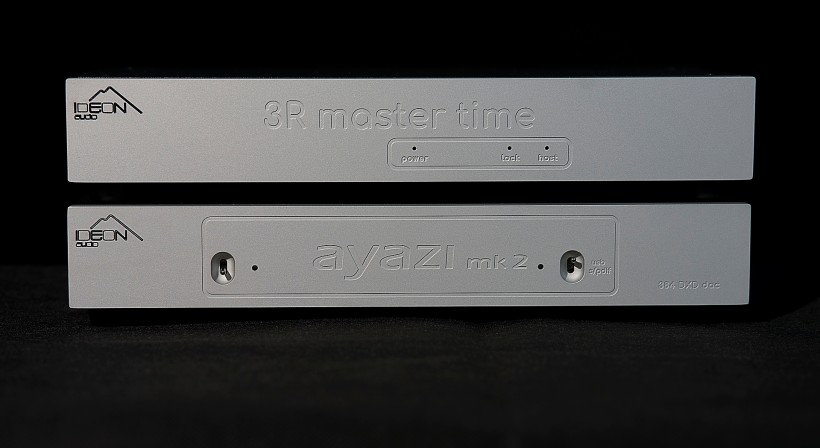 After the Show I visited Ideon Audio website to learn more about the company and what they offer and that’s what I read first:
After the Show I visited Ideon Audio website to learn more about the company and what they offer and that’s what I read first:
Ideon Audio was founded in 2015 by a team of audiophiles including an experienced engineer, devoted to design and build user-friendly high-end music reproduction products at an affordable price.
As you can see, that’s quite a young company although I’m the last one to hold that against them. I had a chance to listen to many fantastic debuts in this industry so while experience is an important factor when designing audio product, true passion and love for music are equally consequential to achieving great sonic results. The aforementioned quote suggests that Ideon Audio team is a nicely balanced one as it includes experienced professionals and music passionates. The next one, explaining the goals of the company, is no less convincing:
Our approach is to connect the listener with the experience of his and her favorite music. We use technology, our experience as audiophiles, our shared passion for music, and our fair share of hard work, to develop products which help create excitement and inspire emotions in the listener: i.e. create a total musical experience. And to make it all as accessible as we possibly can: affordable and user-friendly.
And last but not least:
Music is what matters most at Ideon Audio: turning sound into an experience.
From my perspective of a first and foremost music lover that’s what I would like to hear from all audio manufacturers, because what we all look for is as realistic, as immersive musical experience as possible, right? At least that’s what I look for.A visit to a company’s website revealed, that as for today the lineup includes two D/A Converters, two USB re-clockers or as manufacturer calls them – USB conditioners, and linear power supply for the smaller of the latter. It seems that also a music server is coming but there is no time frame given for it. As you can see within a relatively short time this Greek company has managed to develop an interesting portfolio focused around playback of digital music, particularly one played from music files. Some of their products have been already upgraded to mk 2 versions which proves that the work they do continues all the time, that they keep working to deliver even better experience to their customers. Ultimately, Ideon Audio decided to send the above mentioned 3R Master Time re-clocker along with another D/A Converter from their lineup, their basic model called AyaZi mk2. These two devices share almost identical, same-size chassis so make up to a really good looking system.
Design
The AyaZi mk2 DAC seems to be a simple, compact device. Its sturdy, well-made and finished chassis measures just 29x17x8cm and features two inputs – USB and coaxial, one single-ended analogue output, IEC power inlet, two flip switches in front (on/off and input selector), two LED indicators, and that’s basically it. No fancy display, no plethora of inputs, no upsampling. It seems that its designers focused their efforts on quality over quantity/versatility. The coaxial input features a low-jitter re-clocking controller from Wolfson, the USB one is full Class-2 and it features proprietary electrostatic protection, developed by Ideon Audio. To further refine the Ayazi’s sonic performance manufacturer selected Crystek’s CCHD-957 HCMOS oscillator, one that was developed specifically for audio use. At the heart of AyaZi mk2 works a Sabre DAC chip using a patented time-domain jitter eliminator technology. Another key component is an ultra low-noise power supply developed in-house with a custom-made transformer, high capacity main DC filter and selected audiophile series capacitors.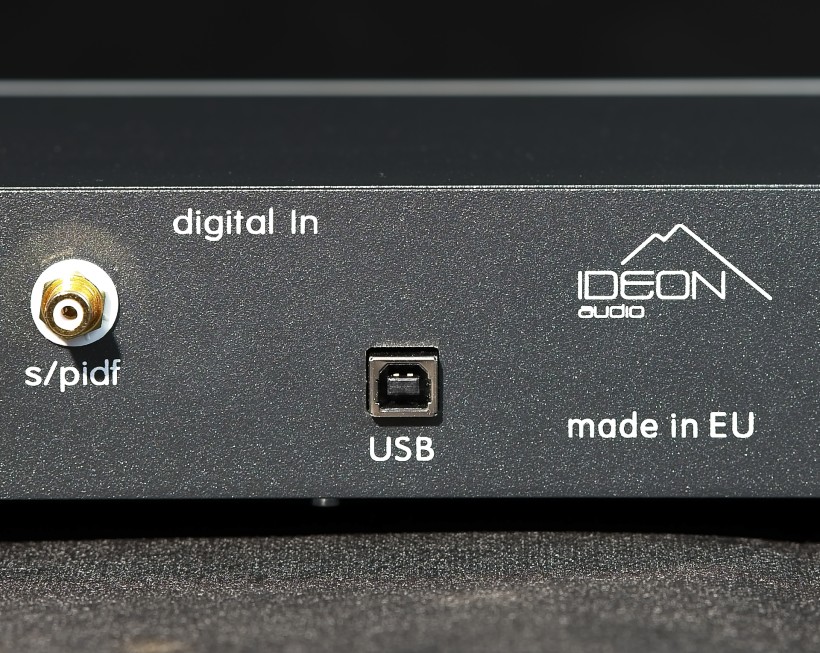 The specification proves quite impressive with SNR (DC to 20kHz) >112dB and THD N (1kHz FS 96 kS/s) <0.002%, plus ability to play hi-res PCM files up to 384 kHz (via USB and up to 192 kHz via coax). To play DSD files one has to first convert them to PCM, which most modern software music player can do on-the-fly. As a fan of DSD format I’d rather have an option to play it in native form, but that’s just me. I read somewhere an explanation from one of the guys behind Ideon Audio that first of all DSD format as such has some flaws (high frequency noise, for example) and secondly most recordings are actually made or at least processed in PCM so in their opinion it is better to play music using original format. A reasonable explanation that despite my personal preference I am not going to dispute. After all, all I really care about is music and how well it is presented, how convincing experience it delivers – that does not really depend on a format used to encode it, and only to some extend of the resolution. Anyway, to play music from a Windows based computer one has to install a proper driver available on Ideon Audio’s website. Users of iOS and Linux based devices do not need to install any additional drivers.
The specification proves quite impressive with SNR (DC to 20kHz) >112dB and THD N (1kHz FS 96 kS/s) <0.002%, plus ability to play hi-res PCM files up to 384 kHz (via USB and up to 192 kHz via coax). To play DSD files one has to first convert them to PCM, which most modern software music player can do on-the-fly. As a fan of DSD format I’d rather have an option to play it in native form, but that’s just me. I read somewhere an explanation from one of the guys behind Ideon Audio that first of all DSD format as such has some flaws (high frequency noise, for example) and secondly most recordings are actually made or at least processed in PCM so in their opinion it is better to play music using original format. A reasonable explanation that despite my personal preference I am not going to dispute. After all, all I really care about is music and how well it is presented, how convincing experience it delivers – that does not really depend on a format used to encode it, and only to some extend of the resolution. Anyway, to play music from a Windows based computer one has to install a proper driver available on Ideon Audio’s website. Users of iOS and Linux based devices do not need to install any additional drivers. The 3R Master Time features very similar chassis although there are no flip-switches on the front, just three LED indicators. On the rear panel one finds USB input and output, IEC socket and two small switches. One of the latter turns the device on and off, the other allows user to cut off noisy 5V power from computer/server and deliver a pure 5V to DACs that requires it or cut it off completely. The latter function will be DAC dependent – some require USB signal to include also the 5V power, some don’t. If the latter is the case, one should just cut the 5V off. The 3R Master Time does not require any separate driver – it is sort of transparent for the source you use. The computer, music server or streamer you use should always „see” the DAC that’s behind the USB re-clocker. As the key features of this device manufacturer names: a triple ultra-low noise linear power supply, femto, ultra-low noise phase clock, dual re-drive signal conditioning topology and last but not least a modular digital core that makes the device ready for future updates.
The 3R Master Time features very similar chassis although there are no flip-switches on the front, just three LED indicators. On the rear panel one finds USB input and output, IEC socket and two small switches. One of the latter turns the device on and off, the other allows user to cut off noisy 5V power from computer/server and deliver a pure 5V to DACs that requires it or cut it off completely. The latter function will be DAC dependent – some require USB signal to include also the 5V power, some don’t. If the latter is the case, one should just cut the 5V off. The 3R Master Time does not require any separate driver – it is sort of transparent for the source you use. The computer, music server or streamer you use should always „see” the DAC that’s behind the USB re-clocker. As the key features of this device manufacturer names: a triple ultra-low noise linear power supply, femto, ultra-low noise phase clock, dual re-drive signal conditioning topology and last but not least a modular digital core that makes the device ready for future updates.
Sound
To use both devices together one needs two USB cables. Since I had on loan the best USB cables I know, products of the StavEssence Audio, I did not hesitate to use them. I decided to divide this test into three stages, some of them requiring one, some both USB cables. Both devices I received for the test were actually brand new so for the first week or so I just connected them both to the source of USB signal and let them run almost 24/7. After the break-in period I chose to firstly listen to the AyaZi mk2 DAC alone, then combine it with 3R Master Time and finally use the latter in the setup I use as my current reference (with my Audio PC and LampizatOr DAC). For part of the test I also used the LDMS, that was here for its review and proved to outperform my own PC.
Step 1 – AyaZi mk2
Considering these two particular digital inputs I guess a system the Ideon Audio’s designers had in mind included a CD transport (coaxial SPDIF) and some sort of music server (USB). I gave up CDs completely quite a few years ago so I don’t really have any decent CD Transport anymore. I could use the Berkeley Audio Design Bada Alpha USB converter (still one of the best there are) but the original source of a signal would still be the same – my custom Audio PC or LDMS. This made no sense to me at all, so I just went with USB input and used both of the aforementioned components (interchangeably) as sources of signal. Driver installation on my Windows 10 PC was pretty straight forward, with the LDMS I had help from its designer, Lucas Domansky, so also no problem at all for me.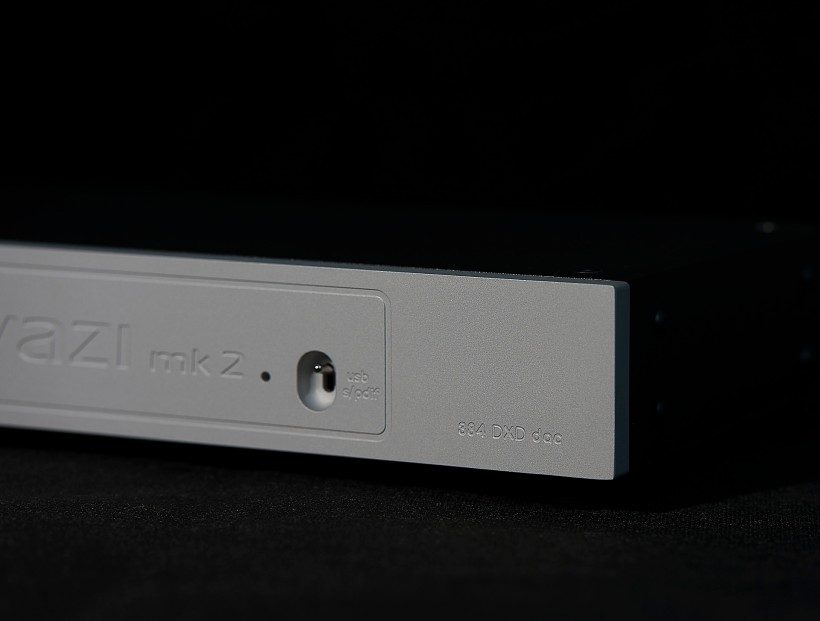 I played dozens of my favorite albums, as usually disregarding completely files resolution and formats (although only lossless ones). As mentioned before, for me it is the musical experience that matters most, and you can get amazing results in this regard not only from hi-res files, but even from high quality 16/44 ones. The AyaZi mk2, as promised by its designers, delivers quite an impressive performance. Sometimes switching from my 9 kEUR LampizatOr Golden Atlantic to significantly less expensive DACs, at least at first, is quite a discouraging if not painful experience. But this time was different. That is not to say, that both are equally good – I could hear why my DAC costs way more – but that the AyaZi mk2 did a really good job, to be honest, better then expected from a less then 2 kEUR DAC. It is quite resolving, pure and transparent sounding device, yet naturally warm and musically involving. With some not so expensive DACs I can hear some „nervousness” of the presentation caused by digital artifacts and/or timing problems, but not with this Greek converter. The sound was calm, refined and orderly, but if you think it means it lacked in terms of energy or dynamics – think again. Some rock and blues albums proved that drive, PRAT, nicely extended, well defined, powerful when needed bass, were definitely among numerous qualities of the AyaZi mk2.
I played dozens of my favorite albums, as usually disregarding completely files resolution and formats (although only lossless ones). As mentioned before, for me it is the musical experience that matters most, and you can get amazing results in this regard not only from hi-res files, but even from high quality 16/44 ones. The AyaZi mk2, as promised by its designers, delivers quite an impressive performance. Sometimes switching from my 9 kEUR LampizatOr Golden Atlantic to significantly less expensive DACs, at least at first, is quite a discouraging if not painful experience. But this time was different. That is not to say, that both are equally good – I could hear why my DAC costs way more – but that the AyaZi mk2 did a really good job, to be honest, better then expected from a less then 2 kEUR DAC. It is quite resolving, pure and transparent sounding device, yet naturally warm and musically involving. With some not so expensive DACs I can hear some „nervousness” of the presentation caused by digital artifacts and/or timing problems, but not with this Greek converter. The sound was calm, refined and orderly, but if you think it means it lacked in terms of energy or dynamics – think again. Some rock and blues albums proved that drive, PRAT, nicely extended, well defined, powerful when needed bass, were definitely among numerous qualities of the AyaZi mk2.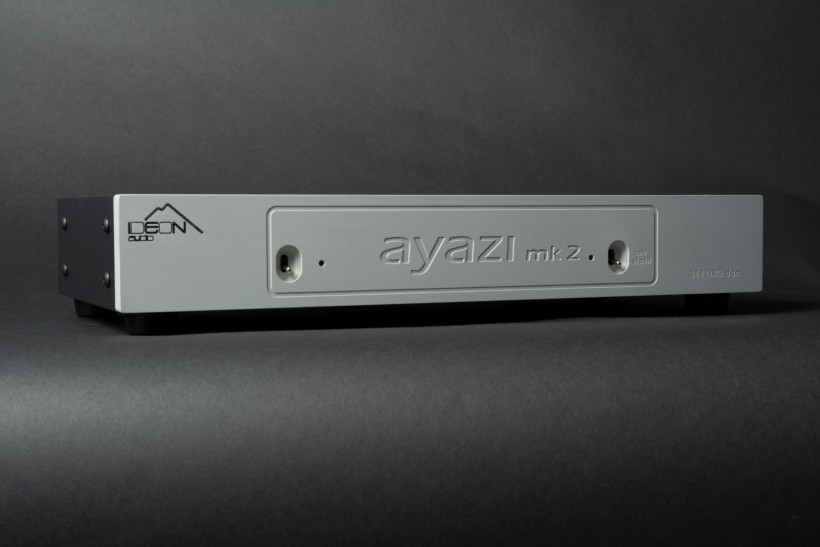 Yet, the key band range is the midrange – smooth, colorful (not colored!), open, communicative, rich with information including lot of small details and subtleties. It is the mid-part of the band that makes AyaZi mk2’s presentation so enjoyable, so easy to listen to. It combines richness with clarity, smoothness with dynamics, good differentiation with coherence. The top end is open and airy, but never bright or harsh. The reviewed DAC presents music (depending obviously on a recording) usually on quite large, deep soundstage. The latter can be quite impressive since AyaZi mk2 makes a good use of all acoustic cues particularly in live recordings. The sound as a whole is slightly warm, sort of intimate. Yet it is resolving and transparent enough to nicely differentiate recordings allowing them to keep their unique characters. That’s quite a rare feature among relatively inexpensive DACs. I listened to it for hours at time with no sighs of any fatigue, which is the best prove there is, of a natural, organic nature of this presentation.
Yet, the key band range is the midrange – smooth, colorful (not colored!), open, communicative, rich with information including lot of small details and subtleties. It is the mid-part of the band that makes AyaZi mk2’s presentation so enjoyable, so easy to listen to. It combines richness with clarity, smoothness with dynamics, good differentiation with coherence. The top end is open and airy, but never bright or harsh. The reviewed DAC presents music (depending obviously on a recording) usually on quite large, deep soundstage. The latter can be quite impressive since AyaZi mk2 makes a good use of all acoustic cues particularly in live recordings. The sound as a whole is slightly warm, sort of intimate. Yet it is resolving and transparent enough to nicely differentiate recordings allowing them to keep their unique characters. That’s quite a rare feature among relatively inexpensive DACs. I listened to it for hours at time with no sighs of any fatigue, which is the best prove there is, of a natural, organic nature of this presentation.
Step 2 – Time to add the 3R Master Time to the mix
I guess most of you, I mean those who treat music servers/streamers/computers seriously as sources for their audio systems, use some performance improving devices. There are quite a lot of them on the market that play different roles. In my custom Audio PC I use, for example, the JCat Femto USB card which simply delivers a much higher quality signal then a regular USB port and it doesn’t take an „audio degree” to notice that. The whole computer is fed from HDPlex linear power supply that makes another huge difference in terms of sound purity and resolution, and the JCat card itself, when needed (if DAC requires 5V feed) receives a clean power from iFi’s small PS. I also use optical isolator on LAN (as I play music files from NAS over the network it is important to eliminate any noise from that may come from there) and JCat USB isolator between the computer and DAC. Each of these elements, doing their specialized job, contributes to a final result – sound that I really, really love and that I believe is also objectively really good. The 3R Master Times’ job is, as stated by the manufacturer, threefold. It “redrives”, “reclocks” and “regenerates” the USB signal. Adding it between LDMS and AyaZi mk2 went smoothly – no software or hardware problems. Even though, after the presentation of 3R’s capabilities during the Audio Video Show, I knew more or less what to expect, after maybe 10 seconds of the first track my jaw dropped to the floor, so to speak. The difference is simply stunning. It is like replacing a DAC with another, much more expensive one. First of all, it proves how important the quality of signal sent to DAC via USB is – it’s not just zeros and ones. Secondly, it strongly indicated, that 3R Master Time is exactly what its name suggests – a Master in improving USB signal. So what exactly did improve with it in a signal’s path? Well, literally everything. Without it AyaZi mk2 already stood out among other 2-4 kEUR DACs I know. With 3R Master Time, while their combined price was still only a half of my LampizatOr Golden Atlantic, it wasn’t so obvious anymore, which one sounded better. I mean, my (tube) DAC still had some advantages, for example, it delivered more palpable, more three-dimensional performance, and female vocals were still more intimate, sexy. But the Ideon Audio setup sounded purer, more transparent, more orderly, also more dynamic, and it had more punch. For half the price it was able to offer a competitive performance to my DAC, and I guess one in every two audiophiles, depending on individual preferences and expectations (regardless of budget), could decide not to spend twice as much money to get LampizatOr.
Even though, after the presentation of 3R’s capabilities during the Audio Video Show, I knew more or less what to expect, after maybe 10 seconds of the first track my jaw dropped to the floor, so to speak. The difference is simply stunning. It is like replacing a DAC with another, much more expensive one. First of all, it proves how important the quality of signal sent to DAC via USB is – it’s not just zeros and ones. Secondly, it strongly indicated, that 3R Master Time is exactly what its name suggests – a Master in improving USB signal. So what exactly did improve with it in a signal’s path? Well, literally everything. Without it AyaZi mk2 already stood out among other 2-4 kEUR DACs I know. With 3R Master Time, while their combined price was still only a half of my LampizatOr Golden Atlantic, it wasn’t so obvious anymore, which one sounded better. I mean, my (tube) DAC still had some advantages, for example, it delivered more palpable, more three-dimensional performance, and female vocals were still more intimate, sexy. But the Ideon Audio setup sounded purer, more transparent, more orderly, also more dynamic, and it had more punch. For half the price it was able to offer a competitive performance to my DAC, and I guess one in every two audiophiles, depending on individual preferences and expectations (regardless of budget), could decide not to spend twice as much money to get LampizatOr.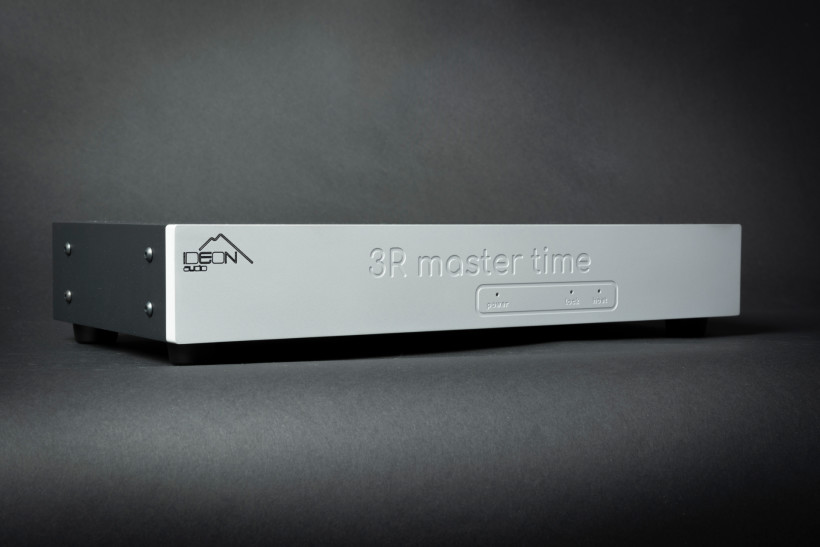 With the 3R Master Time the performance of AyaZi mk2 became even less „digital”, or more „analogue”, if you will, despite the fact it was not „digital” at all, when the Greek DAC performed on its own. It also gained in terms of dynamics, both on macro and micro level. Bass was now even better extended, had more punch, became more snappy – a great prove of improved timing (there „Time” in device’s name after all). Top end opened up even more then before, but it remained smooth, sort of delicate, and yet more refined, more vibrant at the same time. The whole presentation got more spacial, with bigger, more precisely defined, more three-dimensional images. There was more air filling up the soundstage which allowed (acoustic) instruments to breathe, and thus to sound more natural. All the ambiance cues – reverbs, decay and so on, were more audible enhancing my experience particularly with live recordings, making me more of a participant then just a listener. One of the small, yet having maybe even the biggest effect, new feature introduced with 3R Master Time was a pitch black background. That comes from a cleaner signal/power or in other words – much less background noise. That’s something you can’t even really hear when it’s there, and still, when it’s gone it makes a of a difference. The sound is purer, more precise, better pronounced, you can hear more low level details, subtleties, tiny shadings of timbre, smallest shifts in dynamics an so on. All that results in a more realistic, more vivid presentation that creates a more involving musical experience. That’s a clear win!
With the 3R Master Time the performance of AyaZi mk2 became even less „digital”, or more „analogue”, if you will, despite the fact it was not „digital” at all, when the Greek DAC performed on its own. It also gained in terms of dynamics, both on macro and micro level. Bass was now even better extended, had more punch, became more snappy – a great prove of improved timing (there „Time” in device’s name after all). Top end opened up even more then before, but it remained smooth, sort of delicate, and yet more refined, more vibrant at the same time. The whole presentation got more spacial, with bigger, more precisely defined, more three-dimensional images. There was more air filling up the soundstage which allowed (acoustic) instruments to breathe, and thus to sound more natural. All the ambiance cues – reverbs, decay and so on, were more audible enhancing my experience particularly with live recordings, making me more of a participant then just a listener. One of the small, yet having maybe even the biggest effect, new feature introduced with 3R Master Time was a pitch black background. That comes from a cleaner signal/power or in other words – much less background noise. That’s something you can’t even really hear when it’s there, and still, when it’s gone it makes a of a difference. The sound is purer, more precise, better pronounced, you can hear more low level details, subtleties, tiny shadings of timbre, smallest shifts in dynamics an so on. All that results in a more realistic, more vivid presentation that creates a more involving musical experience. That’s a clear win!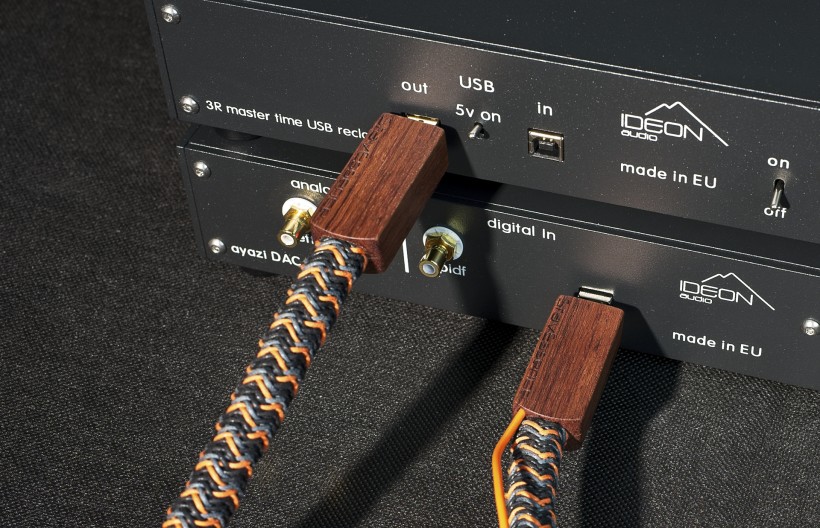
Step 3 – 3R Master Time in my system
Of course I was so impressed with 3R Master Time influence on the sound of the AyaZi mk2 that I had to try it in my own system, with my custom Audio PC and LampizatOr Golden Atlantic DAC. As I mentioned before, the USB signal re-clocker under review enhanced Ayazi’s performance so much, that in some respects it was able to compete with a DAC twice as expansive as 3R and AyaZi mk2 combined. The obvious question was: could 3R Master Time have as significant impact on the 9 kEUR LampizatOr’s performance? Because if it did I would have to consider it a potential valued addition to my reference system. I had to try. Adding it to my system turned out to be not so straight forward operation, as I couldn’t use the JCat USB Isolator. With this device plugged between computer and the 3R, the former did not „see” the DAC behind 3R Master Time. When I took the USB Isolaton out of equation everything worked flawlessly. So I ended up comparing performance of my regular setup (JCat USB card and USB Isolator) versus JCat USB card and 3R Master Time (without Isolator in the middle). The difference might not have been as impressive (especially at first) as with the AyaZi mk2, but it was still there, loud and clear, so to speak. This time other sonic elements attracted my attention first. Individual sounds were better pronounced, the sustain and decay phases (which was particularly clear with, for example, piano) seemed clearer and lasted longer. There was more air in the sound that was more open and spacious (soundstage seemed even deeper with 3R) and instruments were more palpable, present. Enhancing these particular features for already excellent in these respects tube DAC was an impressive achievement. While the re-clocker enhanced bass performance – it was better defined, slightly deeper, with a more immediate attack, it did not change its overall character. It was still slightly rounded/soft, with not so clear cut leading edge – it’s a tube DAC after all, and I love it for it. I’m not sure if I would like it if the Ideon Audio device changed it. But it didn’t, it did enhance bass or improve it, but sonic character remained untouched.
The difference might not have been as impressive (especially at first) as with the AyaZi mk2, but it was still there, loud and clear, so to speak. This time other sonic elements attracted my attention first. Individual sounds were better pronounced, the sustain and decay phases (which was particularly clear with, for example, piano) seemed clearer and lasted longer. There was more air in the sound that was more open and spacious (soundstage seemed even deeper with 3R) and instruments were more palpable, present. Enhancing these particular features for already excellent in these respects tube DAC was an impressive achievement. While the re-clocker enhanced bass performance – it was better defined, slightly deeper, with a more immediate attack, it did not change its overall character. It was still slightly rounded/soft, with not so clear cut leading edge – it’s a tube DAC after all, and I love it for it. I’m not sure if I would like it if the Ideon Audio device changed it. But it didn’t, it did enhance bass or improve it, but sonic character remained untouched.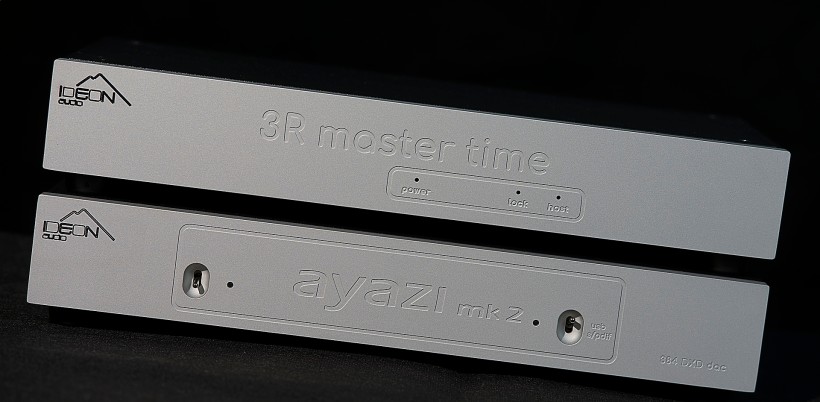 The same goes for the Golden Atlantic’s amazing midrange. While still so palpable, tuneful, warm, organic and resolving, it got better pronounced, purer. There was clearly even better differentiation and also separation which was a clear advantage particularly in more complex symphonic music. That brought additional clarity to the whole presentation and made it not only better in audiophile’s terms on every level, but also even more natural, more immersive, more realistic. With Ideon Audio’s device the scale, momentum and, when needed, truly explosive dynamics were conveyed in a more realistic, convincing way. While the whole presentation was amazingly coherent, due to already mentioned pitch black background all the details, textures, timbres were easier to follow and the music sounded richer, more complete. Same as with the AyaZi mk2 also now the 3R Master Time made vocals more expressive, charismatic, lively and present. It didn’t really matter whether I listened to the wonderful Etta James, Louis Armstrong, Luciano Pavarotti or Steven Tyler – they all sounded so real, so present and each of them in their own way. I would even say, that listening to vocal music with the 3R Master Time became a purely transcendental experience. It became something more then just listening to a replay of recorded music, the performers were simply there expressing their emotions through the music and letting me feel it. That’s exactly what I look for in every audio component, that’s what Golden Atlantic offers, but as it turned out, adding the 3R Master Time to the mix further improved that unique experience. So yes, the Greek USB conditioner would definitely be welcome in my system.
The same goes for the Golden Atlantic’s amazing midrange. While still so palpable, tuneful, warm, organic and resolving, it got better pronounced, purer. There was clearly even better differentiation and also separation which was a clear advantage particularly in more complex symphonic music. That brought additional clarity to the whole presentation and made it not only better in audiophile’s terms on every level, but also even more natural, more immersive, more realistic. With Ideon Audio’s device the scale, momentum and, when needed, truly explosive dynamics were conveyed in a more realistic, convincing way. While the whole presentation was amazingly coherent, due to already mentioned pitch black background all the details, textures, timbres were easier to follow and the music sounded richer, more complete. Same as with the AyaZi mk2 also now the 3R Master Time made vocals more expressive, charismatic, lively and present. It didn’t really matter whether I listened to the wonderful Etta James, Louis Armstrong, Luciano Pavarotti or Steven Tyler – they all sounded so real, so present and each of them in their own way. I would even say, that listening to vocal music with the 3R Master Time became a purely transcendental experience. It became something more then just listening to a replay of recorded music, the performers were simply there expressing their emotions through the music and letting me feel it. That’s exactly what I look for in every audio component, that’s what Golden Atlantic offers, but as it turned out, adding the 3R Master Time to the mix further improved that unique experience. So yes, the Greek USB conditioner would definitely be welcome in my system.
An addendum
Before the review was published I had a chance to check the 3R Master Time with two more high-end D/A Converters – the MYTEK Manhattan 2 and LampizatOr Pacific, both being flagship models of the respective brands. The former cost (with all optional elements on board) around 10 kEUR, the latter (in this particular SE specification) more then 25 kEUR. I will not go into details as I would have to once more repeat most of what I described for Golden Atlantic. Let me just say that even with such fantastic, top notch converters the 3R Master Time still managed to do its job and improve their performances. Again the scale of improvements decreased (as compared to the least expensive AyaZi mk2 where the improvement was most impressive) but obviously there was less to be improved, and yet the improvement was undeniable. And let’s face it – when you buy a 10.000 or 25.000 EUR DAC you don’t really expect that a 2650 EUR add-on will do much good for them. You rather consider buying a new, twice as expensive converter to get a maybe 5% performance boost. Let me just give you a hint – if you have a high end DAC and use USB input a lot and want to further improve its performance, instead of buying another, super-expensive DAC first give the Ideon Audio 3R Master Time a chance. I am pretty sure you will hear a difference and it will be unmistakably positive one. It is for you to decide whether it will be good enough for you, but giving it a try may save you a lot of money.
Summary
My first encounter of the third kind with fruits of minds and hands of the people behind Greek company Ideon Audio turned out to be quite an exciting and enjoyable experience. The AyaZi mk2 DAC, despite its deceitfully attractive price, turned out to be a classy performer ready to go head-to-head even with twice as expensive competitors. So if you’re looking for a DAC that is simple to use and focused on achieving maximum performance from USB and coaxial sources, that’s a proposal you should seriously consider. There aren’t many other D/A converters I know with such a good price/performance ratio simply because the performance part of this calculation is way beyond what one expects at the price level. Having said that, I must admit, that the 3R Master Time is an even more impressive device. Combined with AyaZi mk2 it bravely competed with twice as expensive DAC, even excelling in some areas. When used with the latter, that I believe is a truly remarkable device, it still managed to significantly improve its performance. Actually after this experience listening to my DAC without the Greek USB re-clocker became a somewhat less attractive experience. The two sessions with flagship converters from Mytek and LampizatOr further proved, that the 3R Master Time is able to improve performance of (probably) any DAC, no matter how expensive. So if you want to know what your setup including some USB source (music server, streamer, computer) and USB DAC (even really expensive one) is truly capable of, get the 3R Master Time. It will do amazing things for your system and will further enhance your musical experience.
Technical specification (according to manufacturer):
AyaZi mk2
- Output signal: 2.0 V RMS
- S/N: (DC to 20kHz) >112dB
- THD N: (1kHz FS 96 kS/s) <0.002%
- Crosstalk: -110 dB
- USB input:
Transfer mode: Asynchronous (dual clock)
Device class: Type 2 or above
Bit depth: 32
Samplig rates: 44.1, 48, 88.2,96, 176.4, 192, 352.8, 384 kHz - SPDIF/coaxial input:
Bit depth24
Sampling rates: 44.1, 48, 96, 192 kHz - Analogue output: Stereo unbalanced; impedance: 250 Ω
- Power: 230 OR 120 V AC, 1A, 20W max
- Dimensions: 29cm x 17cm x 8cm
Prices (when reviewed):
- Ideon Audio AyaZi mk2: 1.950 EUR
- Ideon Audio 3R Master Time: 2.650 EUR
Manufacturer: IDEON AUDIO
Associated equipment:
- Analogue front end: J.Sikora Basic MAX turntable, Schroeder CB tonearm , AirTight PC-3, phonostages: Grandinote Celio mk IV, ESE Lab Nibiru V 2.5
- Digital source: a passive, custom PC with WIN10, Roon, Fidelizer Pro 7.3, JCat USB Femto card with iFi power supply, Hdplex linear power supply for PC, JCAT USB Isolator
- D/A Converter: LampizatOr Golden Atlantic
- Power amplifier: GrandiNote Shinai, ArtAudio Symphony II (modified)
- Preamplifier: Audia Flight FLS1
- Loudspeakers: Ubiq Audio Model ONE Duelund Edition. GrandiNote MACH4
- Interconnects: Hijiri Million (RCA), Less Loss Anchorwave (RCA), KBL Sound Zodiac XLR, TelluriumQ Silver Diamond USB
- Speaker cables: LessLoss Anchorwave
- Power cables: LessLoss DFPC Signature, Gigawatt LC-3
- Power:Gigawatt PF-2 MK2 and Gigawatt PC-3 SE Evo+; a dedicated power line with Gigawatt LC-Y in-wall cable; Gigawatt G-044 Schuko and Furutech FT-SWS-D (R)
- Racks: Base VI, Rogoz Audio 3RP3/BBS
- Anti-vibration accessories: ROGOZ-AUDIO SMO40 and CPPB16 platforms and ROGOZ AUDIO BW40MKII feet, Franc Accessories Ceramic Disc Slim Feet and Wood Block Platform


